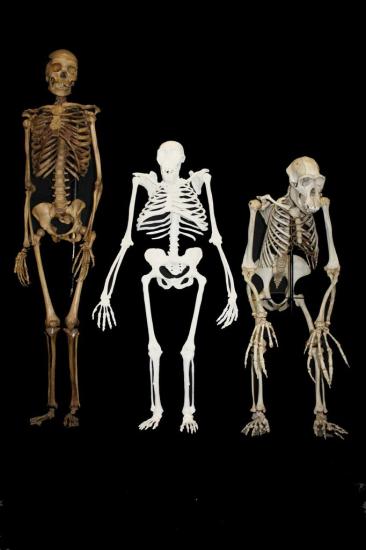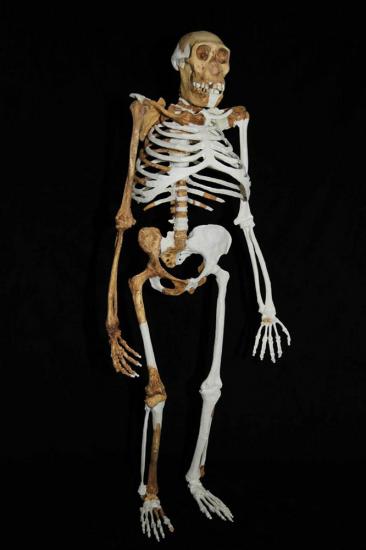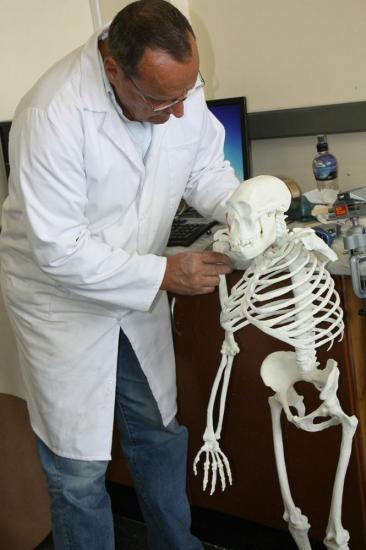New York University
Source - http://phys.org/news/2013-04-australopithecus-sediba-hominid-reveals-human.html#jCp

Composite reconstruction of Au. sediba based on recovered material from MH1, MH2 and MH4 and based upon the research presented in the accompanying manuscripts. As all individuals recovered to date are approximately the same size, size correction was not necessary. Femoral length was established by digitally measuring a complete femur of MH1 still encased in rock. For comparison, small-bodied female modern H. sapiens on left, Male Pan troglodytes on right. Credit: Lee Berger, University of the Witwatersrand
A team of scientists has pieced together how the hominid Australopithecus sediba (Au. sediba) walked, chewed, and moved nearly two million years ago. Their research, which appears in six papers in the latest issue of the journal Science, also shows that Au. sediba had a notable feature that differed from that of modern humans—a functionally longer and more flexible lower back.
Together, the studies offer a comprehensive depiction of some of the most complete early human ancestral remains ever discovered. Since its discovery in August 2008, the site of Malapa—located about 30 miles northwest of Johannesburg—has yielded more than 220 bones of early hominins representing more than five individuals, including the remains of babies, juveniles, and adults. The evidence published in Science is based on two individuals from the site. The fossils from the site date to 1.977 to 1.98 million years in age.

This image shows a reconstruction of Au. Sediba. Credit: Lee Berger; University of the Witwatersrand
"The abundance and remarkable preservation of fossils from Malapa provide unique insights into the way this fascinating extinct species interacted with and moved around in its environment," said New York University anthropologist Scott Williams, the lead author of one of the six papers appearing in Science.
Williams, part of NYU's Center for the Study of Human Origins, and his colleagues authored a paper describing Au. sediba's vertebral column. The work is the first to analyze elements of the cervical, thoracic, lumbar, and sacral regions of the vertebral column in Au. sediba. Their analysis was based on partially complete spines of the two Au. sediba skeletons.
Their study reveals that Au. sediba had a human-like curvature of the lower back, but it was functionally longer and more flexible than that of modern humans.

Peter Schmid assembles the standing skeleton of Au. Sediba. Credit: Bonita de Klerk: University of the Witwatersrand
"They probably walked in a way that we might find strange—a 'compromise' form of bipedalism indicative of a hominin that still partially relied on climbing trees," Williams explained.
He noted that "the adult female is the first early hominin skeleton that preserves an intact terminal thoracic region and this provides critical information on the transition in inter-vertebral joints, and, by inference, mobility of the lower back."
"The bony spine of Au. sediba likely had the same number of vertebrae as that of modern humans," Williams added. "However, it differed in one primary aspect of its configuration—the transition in inter-vertebral articular facets occurred at a higher level of the spine that than normally occurs in modern humans. In combination with other features, a functionally longer lower back would have allowed for a more flexible spine in Au. sediba relative to that of modern humans."
In addition, morphological indicators of strong lumbar curvature suggest that Au. sediba evolved in this regard relative to Au. africanus, which lived between 3.03 and 2.04 million years ago, and closer to the more recent Nariokotome Homo erectus skeleton—to date, the most complete early human skeleton discovered.
The research was conducted at the Evolutionary Studies Institute (ESI) at the University of the Witwatersrand (Wits) in South Africa, where Au. sebida's remains were discovered in 2008.
Overall, the fossils provide an "unprecedented insight into the anatomy and phylogenetic position of an early human ancestor," observed Professor Lee Berger, the project leader from the Wits Evolutionary Studies Institute. "This examination of a large number of associated, often complete and undistorted elements, gives us a glimpse of a hominin species that appears to be mosaic in its anatomy and that presents a suite of functional complexes that are both different from that predicted for other australopiths, as well as that for early Homo.
"Such clear insight into the anatomy of an early hominin species will clearly have implications for interpreting the evolutionary processes that affected the mode and tempo of hominin evolution and the interpretation of the anatomy of less well preserved species."
Prof. Lee Berger, researcher in the Wits Evolutionary Studies Institute (ESI) at the University of the Witwatersrand, project leader and lead author of the introduction entitled Mosaic Anatomy of Australopethicus Sediba, summarises that Au. sediba provides the most comprehensive examination of the anatomy of a definitive single species of early hominin.
"This examination of a large number of associated, often complete and undistorted elements, gives us a glimpse of a hominin species that appears to be mosaic in its anatomy and that presents a suite of functional complexes that are both different from that predicted for other australopiths, as well as that for early Homo," says Berger.
"Such clear insight into the anatomy of an early hominin species will clearly have implications for interpreting the evolutionary processes that affected the mode and tempo of hominin evolution and the interpretation of the anatomy of less well preserved species."
PART.2